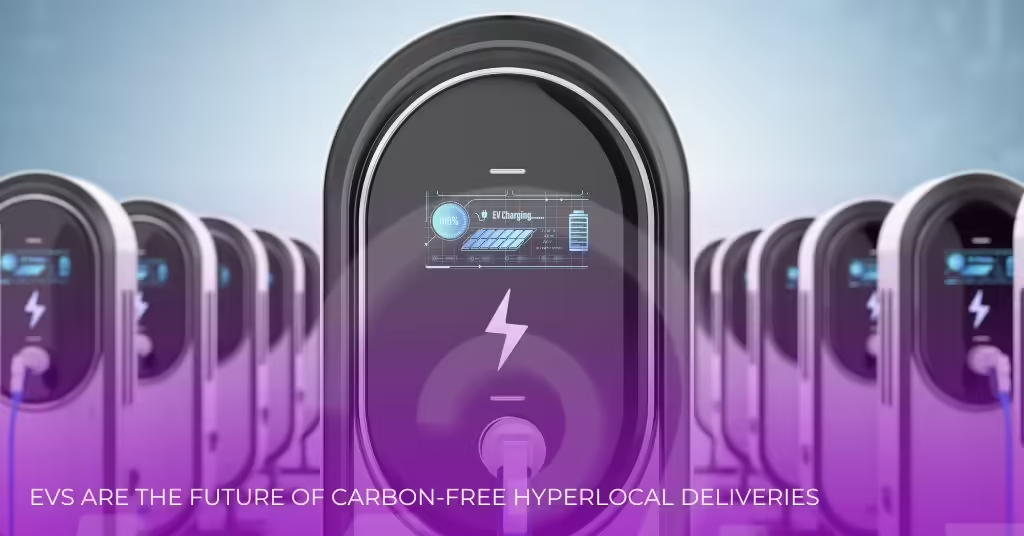تناقش هذه التدوينة كيفية تحول الشركات إلى المركبات الكهربائية لتوفير عمليات تسليم محلية خالية من الكربون وتنفيذ الطلبات بشكل أسرع وأكثر صداقة للبيئة.
في أعقاب جائحة كوفيد-19، أدت الرقمنة السريعة، وتغير تفضيلات المستهلكين، والتوسع المستمر للتجارة الإلكترونية إلى زيادة غير مسبوقة في صناعة التوصيل في جميع أنحاء العالم. تنفق شركات الخدمات اللوجستية الكثير من الأموال على البنية التحتية المتطورة والتقنيات الجديدة والقوى العاملة المدربة لتسريع دورات التوصيل والحفاظ على قدرتها التنافسية.
إلى جانب ذلك، شهد العامان الماضيان نموًا هائلاً في الطلب على خدمات التوصيل في نفس اليوم واليوم التالي، والخدمات الديناميكية حسب الطلب، والتسوق المحلي. أصبحت الراحة الآن العامل الأساسي في تحديد رضا العملاء، ومن ثم الحاجة المتزايدة إلى عمليات توصيل سريعة وفعالة وموثوقة.
في حين أن هذا أمر رائع بالنسبة للنظام البيئي المحلي بشكل عام، فإن البصمة الكربونية المصاحبة تشكل مصدر قلق متزايد. في الآونة الأخيرة، كانت هناك زيادة ملحوظة في عدد المركبات على الطريق للتوصيل إلى المنازل، مما يؤدي إلى ارتفاع انبعاثات الكربون وزيادة استهلاك الوقود. ومن المتوقع أن يؤدي الطلب المتزايد على عمليات التوصيل المحلية إلى زيادة في الانبعاثات الكربونية وزيادة استهلاك الوقود. 36% زيادة في مركبات التوصيل من المتوقع أن تصبح المدن الكبرى ضمن أكبر 100 ضاحية في العالم بحلول عام 2030. ورغم أن هذا قد يبدو جيداً، إلا أنه من المحتمل أن يؤدي إلى تصاعد الانبعاثات الكربونية ما لم يتم تنفيذ تدابير فعالة.
بالنسبة للشركات العاملة في مجال التوصيل المحلي، سواء في مجال البيع بالتجزئة أو التجارة الإلكترونية أو المبيعات المباشرة للمستهلك أو الخدمات اللوجستية للغير أو توصيل المواد الغذائية والبقالة أو الخدمات المنزلية، فإن الخدمات اللوجستية الفعّالة تشكل أهمية بالغة لنجاح السوق. ومع ذلك، وباعتبارها كيانات مسؤولة اجتماعيًا، فإن هذه الشركات ملزمة أيضًا بتخفيف التأثير البيئي لأنشطتها اللوجستية وبناء سلاسل توريد مستدامة.
ولحسن الحظ، يتبنى العديد من مشغلي الأساطيل المحلية ممارسات لوجستية خضراء لتقليل بصمتهم الكربونية. ويهدف هذا التحول نحو الاستدامة إلى تحقيق التوازن بين الحاجة إلى عمليات محلية فعّالة ومسؤولية حماية الكوكب.
على الرغم من أنه من المتوقع أن تكون الخدمات اللوجستية الخضراء في قلب الثورة اللوجستية، إلا أن الوافدين الجدد إلى السوق يمكنهم أيضًا الاستفادة من محركات النمو الأخرى مثل تعيين المنطقة المدعومة بالذكاء الاصطناعي، والإرسال التلقائي، والتحليلات التنبؤية لتقديم حلول ذكية وشاملة، كل ذلك مع خفض التكاليف والأضرار البيئية.
4 فوائد رئيسية للأساطيل الكهربائية في التوصيل المحلي
هذا لا يحتاج إلى أن يقال—إن تبني الأساطيل الكهربائية يوفر حلاً متفوقًا للمؤسسات التي تهدف إلى تحسين التنقل الحضري وإدارة الخدمات اللوجستية. يوفر استخدام الأساطيل الكهربائية في التوصيل المحلي العديد من المزايا:
انخفاض انبعاثات الكربون
يعد النقل أكبر مصدر لتلوث المناخ في العالم. ولمعالجة أزمة المناخ، من الضروري جعل المركبات على طرقنا نظيفة قدر الإمكان. تتسبب انبعاثات الكربون من المركبات التي تعمل بالوقود في مشاكل تنفسية وقلبية وعائية مدى الحياة مثل الربو والتهاب الشعب الهوائية المزمن والسكتة الدماغية والسرطان. يمكن أن تؤدي هذه الأمراض إلى الوفاة المبكرة، إذا تُركت دون علاج. تشير الدراسات التي أجرتها جامعات مرموقة، مثل هارفارد و أكسفوردوقد كشفت الدراسات مرارا وتكرارا عن التكاليف الصحية والاجتماعية الباهظة الناجمة عن انبعاثات المركبات.
باختصار، يرتبط كل جالون من البنزين أو الديزل بتكاليف صحية وبيئية، مما يجعل التحول إلى المركبات الكهربائية خطوة محورية لكل من كوكبنا والصحة العامة. بغض النظر عن نوع شبكة الطاقة تستخدم السيارات الكهربائية لشحنها، وهي تنتج عمومًا انبعاثات غازات دفيئة أقل من نظيراتها التي تعمل بالوقود بسبب كفاءتها في تحويل الطاقة إلى طاقة. وعندما تنتقل المزيد من البلدان إلى مصادر طاقة أنظف، فإن الفوائد البيئية للسيارات الكهربائية ستكون أكثر وضوحًا بالتأكيد.
توفير كبير في التكاليف
يؤدي تشغيل أسطول كهربائي إلى انخفاض كبير في تكاليف الوقود والطاقة لكل ميل مقارنة بمحركات الاحتراق الداخلي التقليدية (ICEs). تحتوي المركبات الكهربائية على أجزاء متحركة أقل من محركات الاحتراق الداخلي، مما يعني انخفاض تكاليف الإصلاح والصيانة. ومع ذلك، لا تزال تتطلب صيانة منتظمة، بما في ذلك الإطارات والفرامل، فضلاً عن إصلاح البطارية أو استبدالها من حين لآخر. كما تحتوي على فرامل متجددة وتستخدم ناقل حركة أحادي السرعة لإدارة المحرك الكهربائي. تجعل كلتا الميزتين المركبات الكهربائية أقل عرضة للتآكل والتلف، مما يعزز قيمتها الاقتصادية بشكل أكبر.
وعلاوة على ذلك، تقدم معظم البلدان ميزتين ضريبيتين رئيسيتين للسيارات الكهربائية: المساعدات الحكومية لشراء السيارات وخفض الضرائب على الموظفين، وكلاهما، عند دمجهما، يخفض التكلفة الأولية للسيارة الكهربائية بما يصل إلى 50% من تكلفة محرك الاحتراق الداخلي.
تحسين تصور العلامة التجارية
حديثا يذاكر وتشير دراسة من جامعة لادوك أكينتولا للتكنولوجيا إلى أن هناك العديد من المزايا للاستثمار في ممارسات الخدمات اللوجستية الخضراء. فبالإضافة إلى الحد من انبعاثات الغازات المسببة للانحباس الحراري وغيرها من الملوثات أثناء النقل، فإنه يحسن أيضًا الكفاءة الإجمالية من خلال تبسيط العمليات وتحسين المسارات. ويؤدي هذا إلى تنفيذ الطلبات بشكل أسرع وأكثر سلاسة، مما يترجم في النهاية إلى زيادة رضا العملاء. وعلاوة على ذلك، مع تركيز المستهلكين بشكل أكبر على الاستدامة في عمليات صنع القرار، فإن تبني الأساطيل الكهربائية لضمان عمليات التسليم المحلية الخالية من الكربون يؤدي إلى تحسين سمعة الشركة وقيمة العلامة التجارية. ويعكس هذا التحول أيضًا التزام العلامة التجارية بالمسؤولية الاجتماعية ومستقبل أكثر استدامة.
فرصة نمو الأعمال
بعد الوباء، زاد الطلب على التوصيل في نفس اليوم بسرعة. ووفقًا لتوقعات Statista، فإن حجم السوق لهذا النوع من التوصيل، حيث يتم تسليم الطرد في غضون يوم تقويمي أو في غضون نافذة زمنية مجدولة، سينمو بمعدل نمو سنوي مركب قدره 42% بين عامي 2021 و2027.
إن الإمكانات الهائلة التي يتمتع بها هذا القطاع لنمو الأعمال هي السبب الرئيسي وراء تركيز الشركات بشكل متزايد على إضافة عمليات التسليم المحلية إلى محفظة خدماتها بسبب الفوائد العديدة التي قد تجنيها من هذا النموذج التجاري. وول مارت هي مثال جيد على ذلك.
بالإضافة إلى مراكز الإنجاز التقليدية الخاصة بهم، وول مارت تدير الشركة الآن شبكة مكونة من 31 مركزًا متخصصًا لتلبية احتياجات التجارة الإلكترونية و4700 متجر تقع بشكل استراتيجي على بعد 10 أميال من 90% من سكان الولايات المتحدة لتلبية الطلبات عبر الإنترنت بسرعة وكفاءة. كما أنها قادرة على تقديم خدمة التوصيل في نفس اليوم واليوم التالي والمجدول إلى 80% من سكان الولايات المتحدة من خلال الاستفادة من التغطية الشاملة التي توفرها متاجرها.
لا شك أن المركبات الكهربائية سوف تعمل على تحسين خدماتها من خلال تقديم عمليات تسليم أسرع وأكثر كفاءة من المركبات التقليدية التي تعمل بالوقود الأحفوري. على سبيل المثال، تتمتع الدراجات الكهربائية بالقدرة على التنقل في المناطق الحضرية بسرعة، كما أن انخفاض حاجتها إلى التزود بالوقود بشكل متكرر يسمح بتسريع أوقات التسليم ويجعلها المركبة المفضلة للخدمات اللوجستية المحلية.
هل تشكل السيارات الكهربائية مستقبل التوصيل المحلي الخالي من الكربون؟
نعم، بالتأكيد. هناك ضغوط متزايدة على الحكومات لتسريع إزالة الكربون، ولهذا السبب فإنها تضع سياسات طاقة صارمة للتحول إلى موارد موفرة للطاقة، وتحسين العمليات كثيفة الكربون، وتحقيق صافي انبعاثات صفرية. كما أنها تميل إلى معاقبة شراء محركات الاحتراق الداخلي وتشجيع شراء المركبات الكهربائية. وهذا يعني أنه من المرجح للغاية أن نرى المزيد والمزيد من المركبات الكهربائية التي تقوم بتسليم الطلبات المحلية إلى عتبات منازلنا.
ورغم أن الاستثمار الأولي في البنية الأساسية كبير، فإن العائدات طويلة الأجل قد تكون ضعف التكلفة الأولية. ومع ذلك، لا ينبغي لنا أن ننسى أن التحول نحو المركبات الكهربائية في التوصيل المحلي ليس مجرد استجابة للوائح الضريبية المتزايدة على المركبات التي تعمل بالوقود، بل إنه أيضًا خطوة استراتيجية لتلبية طلب المستهلكين على خيارات توصيل أسرع وأكثر استدامة. وينبغي للانتقال إلى المركبات الكهربائية، بكل تأكيد، أن يدعم الهدف الأوسع المتمثل في الحد من البصمة الكربونية وتحقيق الاستدامة في قطاع النقل.

